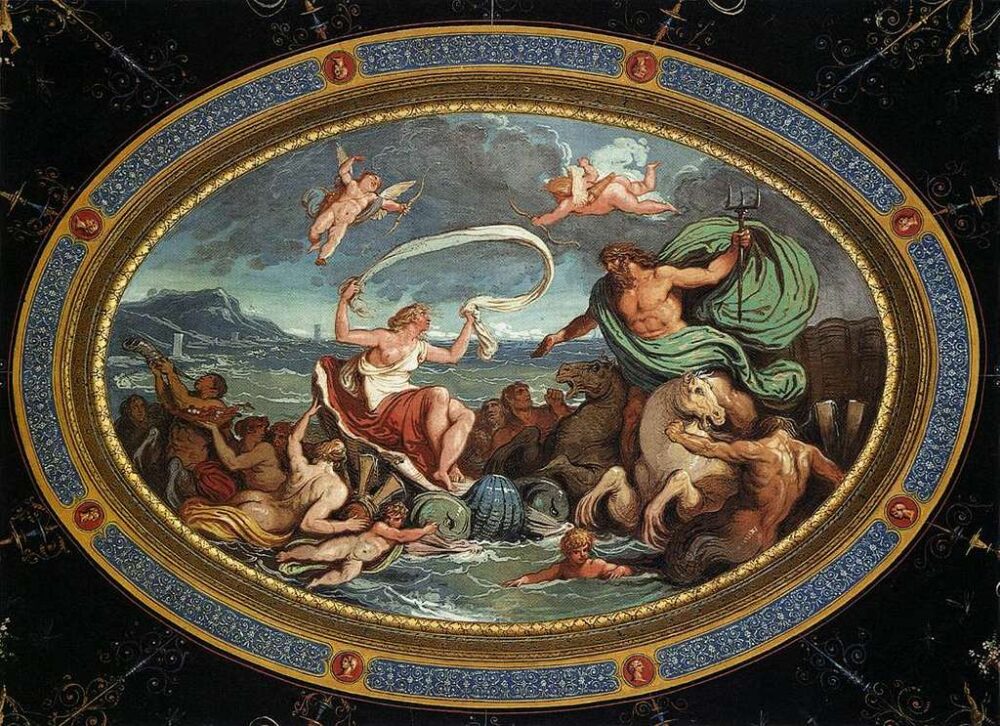Poseidon or Neptune is one of the most famous Greek gods. Brother of Zeus, he is often depicted with his trident. He is the god of the sea, but also dominates earthquakes and horses. Many myths and legends are attached to this Greek mythological figure. Mania tells you more about it.
The founding myth
Poseidon is the son of Cronos and Rhea, like his brother brother Zeus . After Zeus and his brothers defeated the Titans, Poseidon drew lots to take the kingdom of the sea. He held in his hands a trident with which he dominated the seas and oceans.
According to the tradition of the Homeric sagas, Poseidon was under the sovereignty of his elder brother Zeus, and whenever he tried to oppose him, in the end he gave in and obeyed him.

Poseidon, god of the sea and water
With a single gesture, he could provoke terrible storms, deluges, thunderstorms and earthquakes. But he could also instantly calm the waves, create islands and soften the winds. In addition, he was able to gather the rain-laden clouds and pour the waters of heaven onto the earth.
He traveled over the sea in a golden chariot drawn by four white horses. The waves receded as the god Poseidon passed, while all around, dolphins and sea swallows flew above the water and accompanied him on his journey.
More broadly, he was also the god of the rivers that make the earth fertile and the god of fountains.

Finally, Poseidon, like Nereus, was the god of navigation, the one who calms the fury of the waves. As such, he is often depicted accompanied by a dolphin.
In fact, in Greece, when the sea is calm, just before sunset, it’s not impossible to spot dolphins, rising above the waves and accompanying the boats. The presence of the dolphins carries a message and a promise of fine weather.
Amphitrite and Poseidon

Poseidon’s wife was Amphitrite. She was the most beautiful of Nereus’ daughters. She is often depicted seated at Poseidon’s side, as Hera is at Zeus’.
According to legend, Amphitrite, trying to avoid Poseidon, found refuge in Africa, close to the Titan Atlas (who held the celestial vault on his shoulders). But this escapade did not go unnoticed. Indeed, a dolphin spotted him and brought the news to Poseidon’s ears. The latter was thus forced to return to the palace in the depths of the ocean.
The famous wrath of the god of the sea
Poseidon’s fury was terrible. In fact, he was credited with destroying the Persian fleet during the Median Wars. With his trident, reminiscent of the harpoon used by Mediterranean fishermen, he stirred up the waves, creating storms, islands and coastlines.
Earthquakes, a frequent occurrence in Greece, were also often caused by the god’s wrath.
Poseidon and the horse
Poseidon was closely linked to the horse. In Athens, it is said that during the dispute between Poseidon and Athena over possession of the city, the god struck the ground with his trident. According to one version of the myth, a horse came out of it. A second version speaks of a saltwater fountain.
Horses played an important role in the cult of the god who had also taught humans how to tame them. In many towns, horse races were organized in his honor.
Places of worship linked to Poseidon…. and Saint Nicolas!

The most important centers of worship for Poseidon were at Isthmus in the Peloponnese and at Cape Sounion. Cape Sounion at the southern tip of Attica.
It was then “passed on”, as it were, to the Christian religion. Saint Nicolas took over. He is celebrated throughout Greece as the protector of sailors.
Churches and small chapels dedicated to the Saint are built on headlands and promontories, overlooking the sea and offering Saint Nicholas’ protection to sailors.
Mania F.
